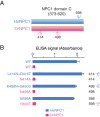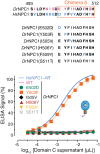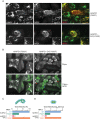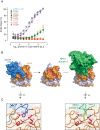A Single Residue in Ebola Virus Receptor NPC1 Influences Cellular Host Range in Reptiles
- PMID: 27303731
- PMCID: PMC4894689
- DOI: 10.1128/mSphere.00007-16
A Single Residue in Ebola Virus Receptor NPC1 Influences Cellular Host Range in Reptiles
Abstract
Filoviruses are the causative agents of an increasing number of disease outbreaks in human populations, including the current unprecedented Ebola virus disease (EVD) outbreak in western Africa. One obstacle to controlling these epidemics is our poor understanding of the host range of filoviruses and their natural reservoirs. Here, we investigated the role of the intracellular filovirus receptor, Niemann-Pick C1 (NPC1) as a molecular determinant of Ebola virus (EBOV) host range at the cellular level. Whereas human cells can be infected by EBOV, a cell line derived from a Russell's viper (Daboia russellii) (VH-2) is resistant to infection in an NPC1-dependent manner. We found that VH-2 cells are resistant to EBOV infection because the Russell's viper NPC1 ortholog bound poorly to the EBOV spike glycoprotein (GP). Analysis of panels of viper-human NPC1 chimeras and point mutants allowed us to identify a single amino acid residue in NPC1, at position 503, that bidirectionally influenced both its binding to EBOV GP and its viral receptor activity in cells. Significantly, this single residue change perturbed neither NPC1's endosomal localization nor its housekeeping role in cellular cholesterol trafficking. Together with other recent work, these findings identify sequences in NPC1 that are important for viral receptor activity by virtue of their direct interaction with EBOV GP and suggest that they may influence filovirus host range in nature. Broader surveys of NPC1 orthologs from vertebrates may delineate additional sequence polymorphisms in this gene that control susceptibility to filovirus infection. IMPORTANCE Identifying cellular factors that determine susceptibility to infection can help us understand how Ebola virus is transmitted. We asked if the EBOV receptor Niemann-Pick C1 (NPC1) could explain why reptiles are resistant to EBOV infection. We demonstrate that cells derived from the Russell's viper are not susceptible to infection because EBOV cannot bind to viper NPC1. This resistance to infection can be mapped to a single amino acid residue in viper NPC1 that renders it unable to bind to EBOV GP. The newly solved structure of EBOV GP bound to NPC1 confirms our findings, revealing that this residue dips into the GP receptor-binding pocket and is therefore critical to the binding interface. Consequently, this otherwise well-conserved residue in vertebrate species influences the ability of reptilian NPC1 proteins to bind to EBOV GP, thereby affecting viral host range in reptilian cells.
Keywords: Ebola virus; NPC1; Niemann-Pick C1; endosomal receptor; filovirus; intracellular receptor; reptiles; viral receptor; virus-host interactions.
Figures










References
-
- Baize S, Pannetier D, Oestereich L, Rieger T, Koivogui L, Magassouba N, Soropogui B, Sow MS, Keïta S, De Clerck H, Tiffany A, Dominguez G, Loua M, Traoré A, Kolié M, Malano ER, Heleze E, Bocquin A, Mély S, Raoul H, Caro V, Cadar D, Gabriel M, Pahlmann M, Tappe D, Schmidt-Chanasit J, Impouma B, Diallo AK, Formenty P, Van Herp M, Günther S. 2014. Emergence of Zaire Ebola virus disease in Guinea. N Engl J Med 371:1418–1425. doi:10.1056/NEJMoa1404505. - DOI - PubMed
-
- Negredo A, Palacios G, Vázquez-Morón S, González F, Dopazo H, Molero F, Juste J, Quetglas J, Savji N, de la Cruz Martínez M, Herrera JE, Pizarro M, Hutchison SK, Echevarría JE, Lipkin WI, Tenorio A. 2011. Discovery of an Ebolavirus-like filovirus in Europe. PLoS Pathog 7:e1002304. doi:10.1371/journal.ppat.1002304. - DOI - PMC - PubMed
Grants and funding
LinkOut - more resources
Full Text Sources
Other Literature Sources
Miscellaneous
